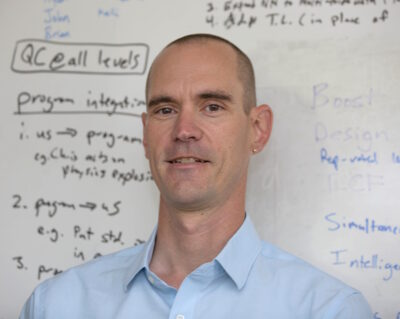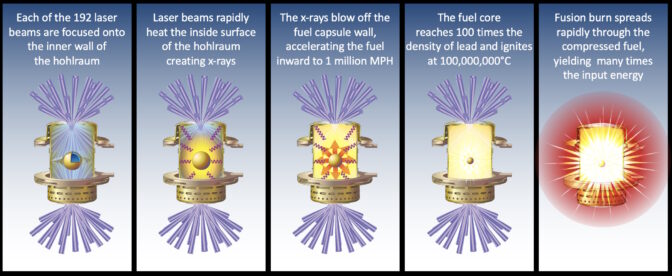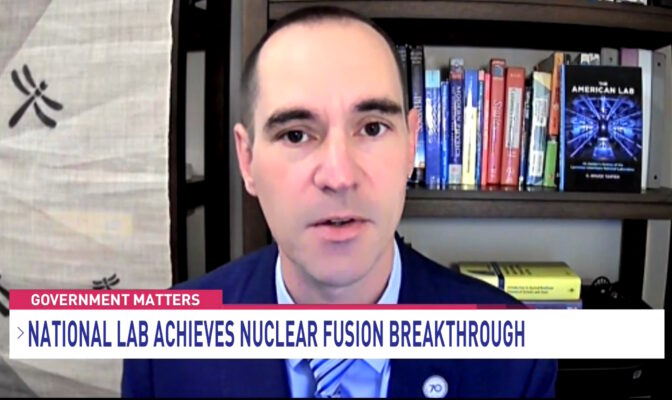Brian Spears says his children will enjoy a more sustainable planet, thanks in part to AI and high performance computing (HPC) simulations.
“I believe I’ll see fusion energy in my lifetime, and I’m confident my daughters will see a fusion-powered world,” said the 45-year-old principal investigator at Lawrence Livermore National Laboratory who helped demonstrate the physics of the clean and abundant power source, making headlines worldwide.
Results from the experiment hit Spears’ inbox at 5:30 a.m. on Dec. 5 last year.
“I had to rub my eyes to make sure I wasn’t misreading the numbers,” he recalled.
A Nuclear Family
Once he assured himself, he scurried downstairs to share the news with his wife, a chemical engineer at the lab who’s pioneering ways to 3D print glass, and also once worked on the fusion program.

“One of my friends described us as a Star Trek household — I work on the warp core and she works on the replicator,” he quipped.
In a tweet storm after the lab formally announced the news, Spears shared his excitement with the world.
“Exhausted by an amazing day … Daughters sending me screenshots with breaking news about Mom and Dad’s work … Being a part of something amazing for humanity.”
In another tweet, he shared the technical details.
“Used two million joules of laser energy to crush a capsule 100x smoother than a mirror. It imploded to half the thickness of a hair. For 100 trillionths of a second, we produced ten petawatts of power. It was the brightest thing in the solar system.”
AI Helps Call the Shots
A week before the experiment, Spears’ team analyzed its precision HPC design, then predicted the result with AI. Two atoms would fuse into one, releasing energy in a process simply called ignition.
It was the most exciting of thousands of AI predictions in what’s become the two-step dance of modern science. Teams design experiments in HPC simulations, then use data from the actual results to train AI models that refine the next simulation.
AI uncovers details about the experiments hard for humans to see. For example, it tracked the impact of minute imperfections in the imploding capsule researchers blasted with 192 lasers to achieve fusion.

“You need AI to understand the complete picture,” Spears said.
It’s a big canvas, filled with math describing the complex details of atomic physics.
A single experiment can require hundreds of thousands of relatively small simulations. Each takes a half day on a single node of a supercomputer.
The largest 3D simulations — called the kitchen sinks — consume about half of Sierra, the world’s sixth fastest HPC system, packing 17,280 NVIDIA GPUs.
Edge AI Guides Experiments
AI also helps scientists create self-driving experiments. Neural networks can make split-second decisions about which way to take an experiment based on results they process in real time.
For example, Spears, his colleagues and NVIDIA collaborated on an AI-guided experiment last year that fired lasers up to three times a second. It created the kind of proton beams that could someday treat a cancer patient.
“In the course of a day, you can get the kind of bright beam that may have taken you months or years of human-designed experiments,” Spears said. “This approach of AI at the edge will save orders of magnitude of time for our subject-matter experts.”
Directing lasers fired many times a second will also be a key job inside tomorrow’s nuclear fusion reactors.
Navigating the Data Deluge
AI’s impacts will be felt broadly across both scientific and industrial fields, Spears believes.
“Over the last decade we’ve produced more simulation and experimental data than we’re trained to deal with,” he said.
That deluge, once a burden for scientists, is now fuel for machine learning.
“AI is putting scientists back in the driver seat so we can move much more quickly,” he said.

Spears also directs an AI initiative at the lab that depends on collaborations with companies including NVIDIA.
“NVIDIA helps us look over the horizon, so we can take the next step in using AI for science,” he said
A Brighter Future
It’s hard work with huge impacts, like leaving a more resilient planet for the next generation.
Asked whether his two daughters plan a career in science, Spears beams. They’re both competitive swimmers who play jazz trumpet with interests in everything from bioengineering to art.
“As we say in science, they’re four pi, they cover the whole sky,” he said.
